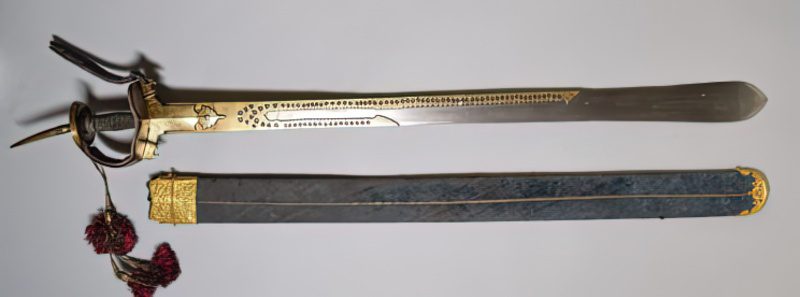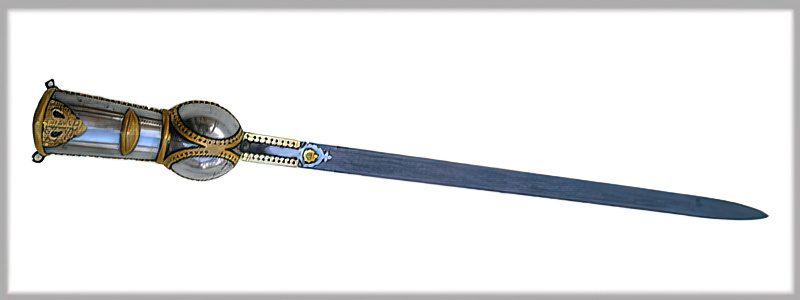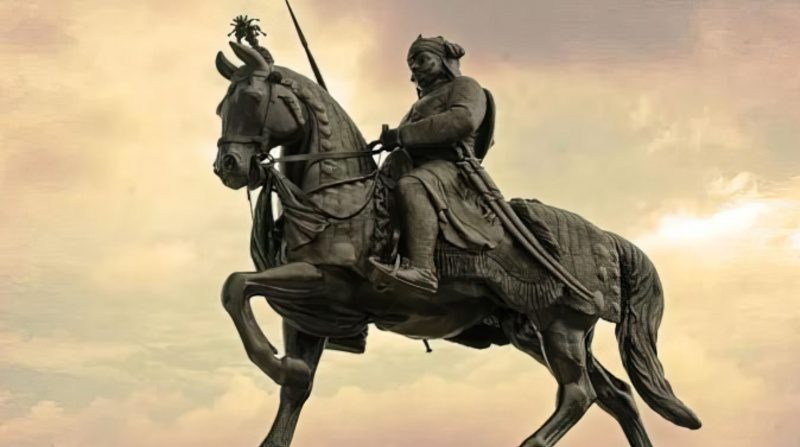18 Indian Swords: History and Characteristics of Popular Blades
NO AI USED This Article has been written and edited by our team with no help of the AI
The history and use of the Indian sword can be traced back to the 5000-year-old Indus Valley Civilization. Over time, the swords changed and developed into different kinds of unique swords.
In this article, we will discuss all the types of Indian swords. We will talk about the most recognizable ones like the Khanda, all the straight and curved Talwar swords, the swords still being used in farming today, and even a few legendary ones.
1. Khanda

The Khanda, or Pattisa, is a straight India sword with two sharp edges. It was also called the Last Stand Indian Sword and was often used in battle scenarios and ceremonial practices. The long, wide, double-edged Khanda also played a large role in the Indian religion. In some ancient Indian religions, it was a symbol of the god Shiva.
The most distinct characteristic of this sword is its blade. It is very long and broad and gradually widens from the guard. The blade tip has a pointy edge that sort of extends from the blade itself. It weighs around 2.6 lbs / 1.2 kg, and its overall length is 37 inches / 95 cm.
The sword originates in India and dates back around the 5th century BC. It was highly used in ancient and medieval times and replaced by the easier-to-use curved Talwar sword.
2. Talwar

The Talwar is a curved Indian sword that emerged from outside influence. It spread quickly through India, resulting in various curved swords. The Talwar replaced the straight and wide Indian swords.
It originated in India around the 14th century and evolved to its final shape about the 16th century. It is approximately 33 inches / 85 cm long and weighs roughly 2.4 lbs / 1.1 kg.
The Talwar blade curves backward. The curved blades of Turkic and Persian swords, like the Kilij and Shamshir, affected its production and appearance, but the blade is not as curved as either of them. Instead, it usually has a disc-shaped pommel and a protected handle guard.
Many people prefer to use swords like the Talwar. Its shape makes it easier to hold on to, but over time, Talwars have changed in the way they are made. One of the most obvious changes in Talwars is that the tip of the blade is now wider.
3. Danda Pata / Pata

The Pata is a straight and double-edged sword from the Indian Peninsula, with a gauntlet built into the handle to protect the hand. In the native language, Marathi, it is often called a Danda Pata. In English, it is often called a gauntlet sword.
The most unusual characteristic is its handle, which is a gauntlet where the user can insert his hand to provide full protection. Infantrymen mostly used the sword with a shield and occasionally for 1v1 duels. Although it appears that the sword can only be used for thrusting, it can also be used for slashing.
It comes from medieval India but was mostly used during the 17th and 18th centuries. The blade can be 10 to 40 inches / 25 cm to 1 meter long.
Sousan / Sossun Patah

The word Sosun Pattah means “lily leaf.” This is because the blade curves forward only at the last third of its length. Some blades dip down and then curl up near the tip. It was often made of wootz steel, just like the Talwar.
There are Hindu and Islamic versions of this type of sword, and sometimes the handle has an Indo-Muslim style like the Talwar. It has a T-section guard, which resembles the Ottoman Kilij sword. Sometimes it can be found with a closed guard to protect the hand of the user.
The Sosun Pattah also comes from medieval India, possibly in the 13/14th century, since the Turkic tribes influenced it at the time. The overall length of the Sossun Patah is around 31 inches / 80 cm, and it weighs approximately 1.3 lbs / 600 grams.
4. Urumi

The Urumi is basically a whip with a metal blade. The Urumi is a weapon that has the ability to fight multiple enemies, or so it is alleged. It is worn around the waist like a belt, with the handle in the place of a normal sword. It can be lashed around in a big circle to protect the owner’s whole body.
The legend of the Urumi is that it might have been used, like in the stories, to kill multiple enemies at once. The blade could form circles around its user and hack and slash enemies’ throats as they keep attacking.
In reality, the Urumi wasn’t used often, especially not in large-scale battles. This is because if you are fighting in a formation with allies beside you, you could easily strike them by mistake. It is, however, a very powerful ceremonial and personal defense weapon used to strike fear in regular people.
The Urumi is definitely the world’s most unorthodox and weird-looking sword.
5. Firangi

The Firangi is a straight Indian blade. The name directly translates to ‘foreign’ or even sometimes as Frankish. The origin of the sword could be that India started producing them from foreign influence or that they were simply brought there with the coming of Portugal.
The sword was highly used and also very symbolic, representing martial power and prestige. It was used in numerous battles by both footmen and cavalry alike. This sword can be used for slashing and thrusting strikes.
It had a very Indian-looking handle, guard, and pommel that was slightly curved. It was the primary weapon of the Mughals. It came from around the 15/16th centuries and was mostly used in the 17th and 18th centuries for mounted warfare. It is about 35 inches / 90 cm long and weighs roughly 2.2 lbs / 1 kg.
6. Hengdang

The Hengdang sword has a blade with a backward bend used in Assam (the most eastern province in India). This sword was mainly under the service of the Ahom dynasty, which was in charge of Assam from the early 1300s until the 1800s.
Since it originates in the very east of India, the Chinese and Japanese swordcraft can be seen here. The handle and pommel are much longer, and the blade has the typical east Asian curved shape. It sometimes has a Chinese red tassel.
It was a sword primarily for nobility and came from the 14th century. It is usually around 35 inches / 90 cm long but can be bigger. It weighs about 2.2 lbs / 1 kg.
7. Sukhela / Dhup / Dhop

This sword is usually known as Dhup or Dhop, but the southern provinces of India call it Sukhela. It is the name for a straight sword with a single-edged blade that comes from around the Deccan region.
It is a cut-and-thrust type of sword used by the Maratha, a confederacy that dominated the sword of India in the 18th and 17th centuries.
The blade is straight at the beginning and slightly curved at the end. It was usually well decorated and used to distinguish parts of the nobility and signify authority. That is why it wasn’t so common among the people. It is around 33 inches / 85 cm long.
8. Indian Rapier

Blades that look like rapiers only showed up in India in the middle of the 17th century, possibly because they were getting to know more and more Europeans at the time. The Rapiers were mostly thrusting swords and performed well against swordsmen who used the cut-and-slash method.
They were the normal size and length (47 inches / 120 cm), just like the European rapier, and were used in the later centuries in mounted warfare. The blade gradually narrowed and ended with a pointy tip.
The biggest difference between the Indian and the European rapier is the unique shapes of the guard, handle, and pommel.
9. Naga Dao

The Dao swords are typical Chinese swords. They originated from Naga, the most northeastern province in India. The Naga Dao is made from this Chinese influence and even resembles one.
The sword, which has a wooden handle and a srectangular shape, was used to dig with and fight. It is still being used today in the same provinces, not for warfare but instead as a machete-like tool for chopping grass, cutting meat, and even digging in the ground.
It can range from 17 to 25 inches / 45 to 65 cm and is 5.7 lbs / 2.6 kg, making it a very heavy and powerful slashing tool.
10. Ram Dao

Ram Dao is a traditional sword used to kill animals as part of Hindu rituals. The big, curved blade is made to cut the head of a sacrificial animal off with one stroke. Ram-Daos are used to hack, and the extra weight on the curved end is meant for beheading, if necessary.
These types of Indian swords are often depicted in Hindu religious images, symbols, and texts. It was highly used all over India, and despite having the Dao in its name, it is very different from the Naga Dao or the Chinese Dao.
11. Odi Kathi / Ayda Katti / Ayudha Katti

Odi Katti, which can also be written as Ayda Katti or Aydha Katti, is a tool and weapon used by the Kodava people of Kodagu, which is in the Indian state of Karnataka. The Ayudha Katti was made from a tool that was used to cut through thick brush. The Odi Katti is different from most blades as it is worn without a sheath.
The Kodava people are in the southwestern parts of India and have been there for two millennia. They created this sword in the 17th century, probably from the Turkish influence of the Yatagan sword.
It is around 13 to 19 inches / 35 to 50 cm long, and the most visual characteristic is the broadening of the blade, making it look like a large sickle.
12. Golia

The Golia sword is a north Indian sword that is mostly found around Punjab. It is a strongly curved one-edged sword resembling the shape of a crescent moon. Even the direct translation of the name means round in Indian.
It comes from the 19th century and was mostly used in mounted warfare, hence the very strong curve that made it better for slashing. It is also a very prestigious sword to own and is usually decorated with lots of diamonds and pearls.
Its length is around 38 inches / 95 cm, and it is very easy to use.
13. Tegha

The Tegha is a type of Indian sword directly inspired by the Islamic sword known as the Zulfiqar. It has a single-edged blade with a very interesting ending at the tip. It could have been used for slashing and in battles, but later started being used for ceremonial purposes since its blade’s tip wasn’t very good for fighting.
Its biggest usage was for executions, which is why it is sometimes known as the executioner’s sword. This sword is easily spotted because its blade gets wider closer to the tip and then splits into two separate tip points.
It is usually around 47 inches / 1.2 meters and can weigh around 7.7 lbs / 3.5 kg, making it a very heavy tool to use.
14. Kayamkulam

Kayamkulam or Kayamkulam Vaal (Vaal means sword in Indian) is a double-edged sword that was mostly employed by the ruling elites and soldiers of the Nair aristocracy in India’s Malabar Coast (South India) and the Kayamkulam princely state.
It is easily distinguishable by its straight blade. It is very rare today because it didn’t survive. It was used to defeat the Dutch army in the battle of Colachel. It is a one-handed sword and is used with a shield.
The Kayamkulamis 33 inches / 85 cm and weighs around 1.1 lbs / 500 grams.
15. Aruval

The Aruval is a type of billhook machete that originates from southern India. It is also known as the Koduval. It is a long scythe with a handle that looks like a knife. It is both an agricultural instrument, a tool, and a weapon. Tamils (a group of people in India) keep the sword as a sign of Karupannar (a black deity and a Hindu demi-god).
Unfortunately, people may associate this sword with gangsters when they hear about it. In cinema, it is the most common weapon. Yet in Kerala (the most southwestern province of India), it is primarily used in agriculture to cut coconuts, clear paths, cut wood, and other such things.
The Aruval has a significant cultural and religious background and sometimes serves as a prominent symbol in India. Some people have even crafted a 30 feet / 9-meter-long Aruval. It is a long sword that can be seen as a sickle with an extension. It reaches a maximum length of 6 feet (180 cm), but the usual hand Aruval is around 1.5 inches (45 cm) long.
16. Moplah

Muslims on the Malabar Coast in southwest India used a sword called the Moplah. It started being used in the 17th century and was used as both a weapon and a tool.
The Moplah sword has a gentle, wide, two-sided blade that is wider near the tip and is slightly curved inward. In some styles, the middle of the blade is much stronger and goes all the way to the tip. This way, the tip can bend if necessary.
Today it is still used in agriculture by some traditional people. Its overall length is around 23 inches / 60 cm.
17. Kirsch / Kirach

The Kirach, or Kirsch sword, comes from the Mughal dominions or Deccan India. The sword originates from the 17th century, and its overall length is around 35 inches / 90 cm.
The Kirach sword is among the rarest kind of Indian swords, and it was usually only given to the most skilled warriors. The blade of this sword is mostly straight, but it curves slightly forward to make the cut more powerful. The blade is likely a later development to the handle and guard, possibly from the 18th or 19th century. It is manufactured of pattern-welded steel with a long, broad fuller. It is stiff and heavy.
18. Double Swords of Mewar – Legendary

Maharana Pratap was purportedly wearing 176 lbs / 80 kg armor, his spear was 240 lbs / 110 kg, and his two swords, which he dual-wielded, were 55 lbs / 25 kg each. His bravery was out of this world, and sometimes he would offer one of his swords if his enemies were unarmed.
The Sisodia dynasty ruled Mewar, and Maharana Pratap was one of its kings. Pratap became a heroic figure and folk hero because he used guerrilla warfare to stop Akbar from expanding the Mughal Empire. This gave other rebels ideas on how to fight against the Mughals, like Shivaji.
Of course, as it is said about so many other legendary and mythical swords, this is purely fiction and didn’t occur in history. Maharana Pratap didn’t wield two swords in his hands at all. Instead, he had one sword that is currently in City Palace Museum. It weighs 4 lbs / 1.8 kg.
Conclusion
India has one of the most interesting sword histories in the world. These weapons have been around for a long time and have been used by everyone, from a simple farmer to the famous Maharana Pratap. Today, they have a very important and symbolic role, and every sword collector should have at least one.

